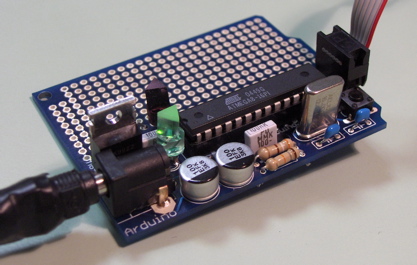26 February 2006

A PCB I designed for Arduino – with prototyping holes so you can solder in extra components. Nothing too new, as I mostly just deleted pieces of the existing Arduino serial board, but I did spend a lot of time rearranging the components to get as much room as possible for the prototyping space. Many thanks to Massimo for teaching me to use Eagle (among other things).
26 February 2006
Some thoughts as I get ready for a two-week Applied Dream workshop entitled “Social Agents for Change” but with a brief vague enough to allow for exploration.
A home admits an infinity of constructions and decorations. Even if most people never design or build their own, by picking a place to live we express our taste in size, materials, location, layout. After moving in, we repurpose rooms, buy new furniture, paint the walls, arrange our belongings. And further, we decorate (consciously or in the course of daily life) - hang pictures, plant flowers, pile mail on a table, stack dishes in the sink, arrange books on shelves, scatter makeup in the bathroom. These activities serve functional, aesthetic, and emotional purposes: reminding us to pay the bills, brightening a room, reminding us of a distant friend. We require of a home both freedom and habit: we would prefer neither walls which we may not paint nor ones whose color we needed to choose each day. The richness of our homes results from our influence over their every characteristics and their accumulation of the traces of our activities. This richness is missing from our digital dwellings (by which I mean file systems, application windows, blogs, and mobile phones as well as the virtual locations in online worlds that more closely mimic physical homes).
Already, software logs many of our actions: the web pages we visit, the chats we have, the people we email. Programs provide functional interfaces to this data with services like auto-completion of URLs, full-text searches of old conversations, automatic indexing of email contacts. The emotional and aesthetic implications of these logs, however, are only beginning to be explored. Flickr displays the number of times a photograph has been viewed, giving a precise but ambiguous indication of the quality of a photo or the popularity of the photographer. iTunes remembers how many times we’ve listened to each song, but not where we were or what we were doing. Anything done on the computer can potentially be recorded, correlated with everything else on the local machine and all public data on the Internet, and stored forever. The limitlessness overwhelms and numbs. We need focus and inspiration, easy actions with rich futures: a Polaroid pinned for 20 years to the same window frame.
(but this is just one aspect… what about the fact that we can instantly make something globally available, we can view the results of our actions immediately, that something can be given without being given up… what does it mean to live digitally? we do it, we’d better design for it)
18 February 2006

After poking around at the XML file that iTunes stores my music library in, I decided to calculate exactly how long I've spent listening to music (at least since I started using iTunes). The Perl script below multiplies the play count for each song by its total time and sums the results. It seems I've spent a total of 3531385497 milliseconds (or just under 41 days) listening to music since October 2004. You?
grep -e "Total Time\|Play Count" ~/Music/iTunes/iTunes\ Music\ Library.xml | perl -ne '($time) = (/<integer>(.*)<\/integer/) if /Total Time/; if (/Play Count/) { ($count) = (/<integer>(.*)<\/integer>/); $total += $time * $count; $time = 0; } print $total, "\n";' | tail -1 | perl -ne '$_ /= 3600000; print $_, "\n"'
Mac users should be able to run this command unchanged at a Terminal prompt. It will print the number of hours you've spent listening to music in iTunes.

